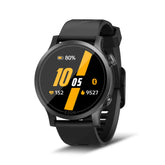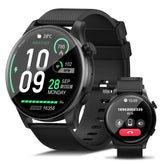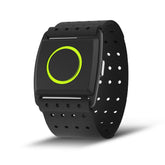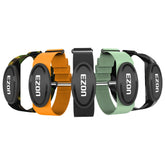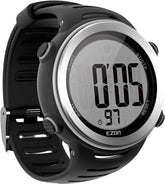Cycling Endurance: Heart Rate Data and Long - Distance Training
Cycling endurance is the art of going farther with less fatigue, and it’s not just about logging endless miles—it’s about training with purpose. A heart rate monitor transforms vague feelings of tiredness into actionable insights, helping you tailor effort to build stamina, tackle long-distance routes, and recover effectively. Whether you’re aiming to conquer a century ride or simply go farther than last month, EZON’s Heart Rate Series and GPS Series provide the data to elevate your cycling endurance. This guide breaks down how to use heart rate data to optimize training, from steady long rides to intense intervals.
1. The Role of Heart Rate in Cycling Endurance
A. Key Heart Rate Zones for Cyclists
Your heart rate reveals which energy systems you’re using—critical for balancing effort and recovery:
- Zone 1 (Recovery): 50–60% MHR (easy spins to flush lactic acid and repair muscles).
- Zone 2 (Endurance): 60–70% MHR (the foundation of long-distance fitness, building aerobic capacity and fat-burning efficiency).
- Zone 3 (Tempo): 70–80% MHR (improves lactate threshold, delaying the “burn” on climbs or headwinds).
- Zone 4 (Threshold): 80–90% MHR (short, intense efforts to boost top-end endurance for sprints or steep hills).
MHR = 220 - age (e.g., a 40-year-old cyclist has a 180 BPM max).
A heart rate monitor (like EZON C009Pro from Heart Rate Series) tracks these zones in real time, ensuring you train the right system for your goals.
2. Long-Distance Training: Building Stamina with Heart Rate
Long rides are the backbone of endurance, and heart rate data ensures you don’t overexert too early:
A. 8-Week Endurance Plan (Zone 2 Focus)
|
Week
|
Long Ride Distance
|
Key Workout
|
Heart Rate Focus
|
|
1–2
|
30–40 km
|
Steady Zone 2 rides (60–70% MHR)
|
Maintain consistent cadence (80–90 RPM)
|
|
3–4
|
50–60 km
|
Add 1x 10km Zone 3 segment mid-ride
|
|
|
5–6
|
70–80 km
|
2x 15km Zone 2 + 5km Zone 3 intervals
|
Monitor recovery between zones with C009Pro
|
|
7–8
|
100+ km
|
Full Zone 2 ride with 1x 20km Zone 3 finish
|
Use R7’s battery (20-hour GPS mode) for full-ride tracking
|
B. Route-Specific Tips for Long Rides
- Flat Roads: Prioritize staying in Zone 2 (60–70% MHR) to conserve energy for longer distances. Use R7’s GPS to log wind direction—adjust effort when fighting headwinds to avoid drifting into higher zones.
3. Interval Cycling: Boosting Endurance with Intensity
Short, intense efforts build the “top end” of your endurance, letting you push harder during long rides. Heart rate monitors ensure these intervals are effective, not wasteful:
A. Science-Backed Intervals for Endurance
- 30/30s: 30 seconds in Zone 4 (80–90% MHR) + 30 seconds in Zone 2. Repeat 10x. This improves your body’s ability to clear lactic acid, delaying fatigue.
- 5x5s: 5 minutes in Zone 3 (75–80% MHR) + 2 minutes in Zone 1. Ideal for building the stamina needed to tackle sustained climbs.
Use EZON R7 (from GPS Series) to program intervals—its vibration alerts signal when to shift zones, so you focus on effort, not timing.
4. Recovery: Letting Heart Rate Guide Rest
Endurance is built during recovery, and heart rate data tells you when you’re ready to train again:
- Rest Day Monitoring: Check your resting heart rate (RHR) with R7. A 5+ BPM increase from your baseline means your body needs more rest—critical for preventing overtraining.
- Nutrition Timing: Refuel with 40g carbs + 20g protein when your heart rate drops to <65% MHR post-ride. This accelerates glycogen replenishment, ensuring you’re ready for the next training session.
5. EZON Gear for Cycling Endurance
A. R7 GPS Watch: Long-Distance Essential
- Key Features:
- 20-hour GPS battery for 100+ km rides—no mid-ride charging.
- Multi-satellite tracking (GPS/GLONASS) for accurate route logging, so you can repeat high-quality training routes.
- 4-channel PPG sensor to monitor heart rate without chest straps—great for hot days when straps feel uncomfortable.
B. C009Pro Chest Strap: Precision for Intervals
- Advantages: ±1 BPM accuracy during sprints and climbs, with a 365-hour battery that lasts months of training. Perfect for high-intensity interval days when data precision matters most.
C. C022Pro Armband: Comfort for Long Rides
- Benefits: Adjustable elastic band avoids chafing on 4+ hour rides, and its 3ATM waterproofing handles rain or sweat—ideal for all-weather training.
6. FAQs: Cycling Endurance with Heart Rate Data
Q: Can I use a wristwatch instead of a chest strap for heart rate tracking?
- Wrist-based monitors like R7 work well for steady Zone 2 rides, but chest straps (C009Pro) are more accurate during intense intervals or bumpy terrain—pair both for full coverage.
Q: How do I avoid heart rate spikes on hills?
- Shift to a lower gear to maintain a cadence of 80–90 RPM; use C009Pro to keep heart rate <80% MHR on steep sections. This preserves energy for later in the ride.
Q: How long does it take to see improvements in endurance?
- With consistent training using heart rate zones, most cyclists notice they can ride 20–30% farther in 6–8 weeks—track progress with R7’s distance logs.
Ride Farther, Stronger: Data-Driven Endurance
Cycling endurance isn’t about suffering through long rides—it’s about training the right systems at the right intensity. With a heart rate monitor from EZON’s Heart Rate Series and a GPS watch from GPS Series, you’ll turn every pedal stroke into progress, inching closer to your long-distance goals.
EZON Watch: Professional sports technology brand
Search here to get it!
